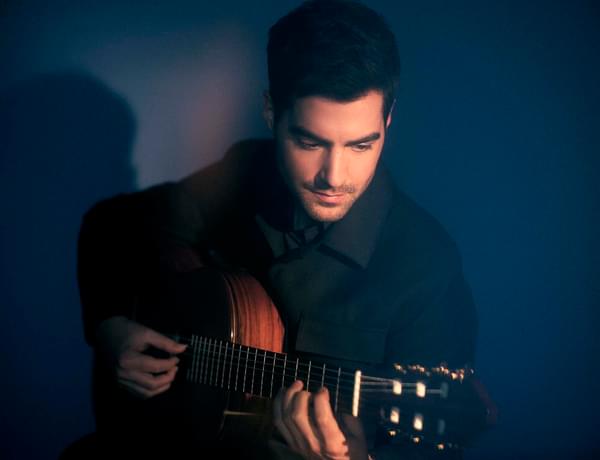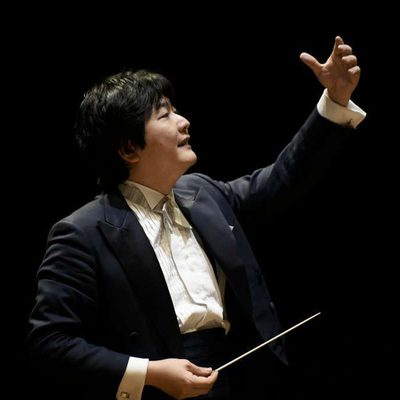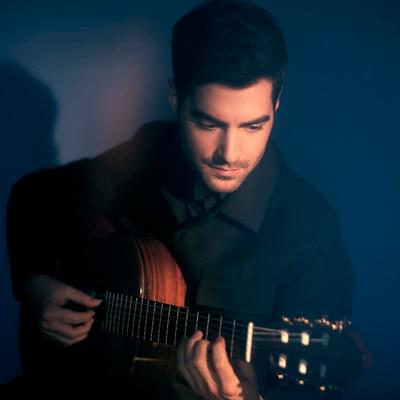Kazuki & MILOŠ

Full programme
- Chabrier, España (6mins)
- Rodrigo, Concierto de Aranjuez (21mins)
- Rimsky-Korsakov, Capriccio Espagnol (15mins)
- Falla, The Three-Cornered Hat: Suite No.1 (10mins)
- Falla, The Three-Cornered Hat: Suite No.2 (12mins)
- Ravel, Boléro (15mins)
Performers

Kazuki Yamada
Conductor
Miloš Karadaglić
Guitar
Introduction
Whenever I think of the City of Birmingham Symphony Orchestra I think of my debut at the Lucerne Festival many years ago. While there, I was invited to an extraordinary concert conducted by principal conductor of the CBSO at the time, Andris Nelsons, who was also making his debut at the Festival to enormous acclaim. It feels so special to be here today at CBSO’s home, Symphony Hall, playing Rodrigo’s Concierto de Aranjuez with the orchestra and maestro Kazuki.
This is one of the most loved and universally-acclaimed works for classical guitar. Each time I perform it though it feels like it’s for the first time, each time setting out new collaborations and relationships between the orchestra, conductor and the audience.
The concerto as a whole tells a very personal story. It is most well-known for its deeply emotional second movement, which Rodrigo wrote as a homage to his and his wife’s personal sadness of losing their first child.
At the same time, the extraordinary playfulness and colour to the outer movements, evoking the beauty of the gardens of Aranjuez, whether through sounds of chirping birds or gushing of the fountains, serves as vivid contrast symbolising the extremes of one’s life journey.
The onomatopoeic sounds of nature really inspire me here while Rodrigo’s melodies truly speak directly to our deepest feelings and emotions. I cannot wait to return to Birmingham to perform this timeless classic.
Miloš Karadaglić
Classical Guitar
Programme notes
A celebration of the music and heritage of Spain – Falla’s sparkling suite, and Rodrigo’s gorgeous concerto, giving a starring role to the classical guitar (and the brilliant Miloš Karadaglić). Chabrier’s España was the result of a Spanish road-trip, while Rimsky-Korsakov seemingly never set foot in Spain – yet his Capriccio is brimming with its folksongs. And Ravel’s mesmeric Boléro, nearly 100 years old, has still got it.
España
Emmanuel Chabrier (1841-1894)
There is a fascinating group of composers who had day-jobs quite separate to their musical lives. Borodin was a chemist, Ives was an insurance agent – and Chabrier worked as a civil servant in the French Ministry of the Interior for nineteen years. Curiously, he benefitted from his lack of formal, conservatoire training: he was by all accounts an eccentric, yet effective, performer at the piano, and produced a series of free-spirited works over his relatively short life. He finally broke free of the Ministry in 1880, becoming a full-time composer until his final illness, during which time he took a road-trip through Spain – and came home with España. His vivid evocation of Spanish-ness – with nods to the dance forms ‘Jota’ (boisterous) and Malagueña (more lyrical) – became an instant and popular hit at its premiere. As fellow Frenchman Poulenc put it in his biographical portrait of Chabrier ‘Baker-boys and milliners’ assistants hummed España on the streets or on the platforms of buses’. The main recurring theme, in which the orchestra imitates a giant guitar, is indeed one of the most contagious tunes in the repertoire: I defy you not to be similarly humming it on the way out of the concert hall.
Concierto de Aranjuez
Joaquín Rodrigo (1901-1999)
Rodrigo’s most famous work, Concierto de Aranjuez for guitar (1939), was inspired by the gardens at the Royal Palace of Aranjuez, south of Madrid. Tellingly, given Rodrigo had been blind since the age of three, he intended to evoke ‘the fragrance of magnolias, the singing of birds, and the gushing of fountains’ of the gardens, rather than any visual element. The whole piece is infused with Spanish idioms, with the traditionally Spanish instrument of the guitar as their vehicle; indeed Rodrigo described his compositional style in general as ‘faithful to a tradition’, rather than in thrall to modern musical developments (Rodrigo lived almost to the Millenium but largely retained this ‘traditional’ style).
The Concierto opens modestly with the solo guitar, strumming rhythmically, then gamely imitated by the whole orchestra, thus setting the pattern for the rest of the first movement. The famous Adagio has a deeply melancholy central theme, first heard on the cor anglais as the guitar accompanies, then echoed by the guitar. Eventually it blossoms into almost Rachmaninoff-like passion across the whole orchestra; towards the end the soloist is given a beautiful, flamenco-like cadenza. Later in life Rodrigo revealed that the Adagio was written in response to the sadness following his wife’s miscarriage in 1939. By contrast to such emotional heft, the brief finale has a courtly, baroque charm, yet with some fiendish cross-rhythms for the soloist.
Capriccio Espagnol
Nikolai Rimsky-Korsakov (1844-1908)
Rimsky-Korsakov never set foot in Spain, and his Capriccio Espagnol is in truth as much about the orchestra as it is about Spain. It is in five movements, each beautifully orchestrated; or rather, as Rimsky-Korsakov rather hotly put it,
"The Capriccio is a brilliant composition for the orchestra. The change of timbres, the felicitous choice of melodic designs and figuration patterns, exactly suiting each kind of instrument, brief virtuoso cadenzas for instruments solo, the rhythm of the percussion instruments, etc., constitute here the very essence of the composition and not its garb or orchestration."
He later added that "The Spanish themes, of dance character, furnished me with rich material for putting in use multiform orchestral effects."
The first movement, a rousing ‘Alborada’ (celebrating the rising sun) is a joyful curtain- as well as sun-raiser, lasting around a minute. The second weaves variations on a wistful theme, very much exploring the ‘change of timbres,’ and ‘felicitous choice of melodic designs’ as the theme passes round the whole orchestra. In the same spirit, the third movement is a reprise of the ‘Alborada,’ but configured for a completely different group of instruments. After a theatrical drum roll and fanfare, a solo violin enters with a flamboyant cadenza (Rimsky-Korsakov originally conceived the whole work as a violin concerto) intended to resemble a ‘gypsy song’. The orchestra then – as in Chabrier’s España – becomes a guitar, plucking an accompaniment to a flute solo, followed by further star turns from clarinet and harp. The orchestra takes on the ‘gypsy song,’ with a lively percussion section adding to the whirling giddiness. More whirls and solos in the ‘fandango’ finale, in which the percussion is augmented by castanets. The movement closes with a final reprise of the festive ‘Alborada.’
Three Cornered Hat, Suites 1 and 2
Manuel De Falla (1876-1946)
De Falla was asked for a ballet score by the famous impresario Diaghilev for his Ballets Russes; he pragmatically adapted an earlier pantomime entitled El Corregidor y la Molinera (the mayor and the miller). The ballet scenario – with choreography by Léonide Massine - revolves around a pompous mayor’s attempt to seduce a miller’s wife. The distinctive tricorn hat belongs to the mayor, and the swapping of clothes becomes part of the farcical fun. The ballet, with stage designs by Picasso, was premiered to rapturous acclaim in London in 1919.
In the first suite (following the action of Act 1), a brief curtain-raiser leads to a depiction of a sultry, hot afternoon. The governor appears – in time-honoured fashion, he is represented by a ponderous bassoon melody – and is teased by the miller’s wife, dancing a wild fandango. She teases him further with the offer of grapes, in a beautifully tender passage for strings. The final section of the suite sees the wife being pursued by the ungainly governor, who is eventually sent packing by the husband with a flurry of semiquavers. Suite 2 dispenses with the action as such, focussing more on dance set-pieces. It opens with the village celebrating the Feast of St John by dancing seguidillas. The husband performs a dramatic flamenco, leading to a raucous ‘Jota’ which concludes the whole piece in glorious high spirits.
Boléro
Maurice Ravel (1875-1937)
Ravel’s Boléro was completed in 1929 in response to a ballet commission from Ida Rubinstein, who had originally wanted orchestrations of pieces by the Spanish composer Albeniz. A ‘Boléro’ is a Spanish dance in three-time, often accompanied by guitar and castanets; Ravel’s work is similarly in three-time, with a side-drum providing the rhythmic pulse (playing its two-bar phrase 170 times) underneath two sinuous melodies. A principal inspiration for its repetitiveness, however, was Ravel’s love of machines and the ‘music’ of factories. He wrote an article called ‘Finding tunes in factories’, and later stated quite plainly that ‘My own Boléro owed its inception to a factory. Some day I should like to play it with a vast industrial works in the background.’
Above all, though, instrumental colours create the extraordinary momentum the piece has, coupled with its continuous crescendo from bar 1 to bar 340. Ravel had heard Rimsky-Korsakov’s Capriccio Espagnol in 1889, and just as the Russian composer quite rightly foregrounded – and challenged – instrumental capabilities, Ravel takes it even further in Bolero. Instruments not only take turns playing one or other of the melodies – those instruments which can ‘swoop’ in the second theme make much of this ability - but Ravel makes extraordinary demands on them. In a Radio 3 documentary on Boléro in the 1980s, an orchestral player tells of a trombonist marking ‘cut’ at his solo in everyone’s score, so terrified was he about the high register. The bassoon entry is similarly stratospheric. Instruments are combined at times to magical, uncanny effect, such as a blend of flute, celesta and high horn. The orchestra assembles, gradually, to full power throughout the 15 minute running time; and with less than a minute to go, Ravel pulls the rug out from everyone by suddenly altering the melodic pattern and changing key. The seemingly unstoppable momentum begins to scramble and fray. As Ravel scholar Deborah Mawer puts it, Boléro ‘is an essay in the construction and destruction of a musical object’. But what a way to go.
© Lucy Walker